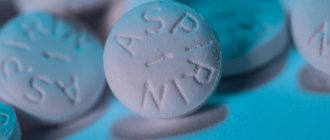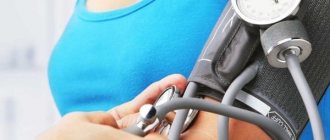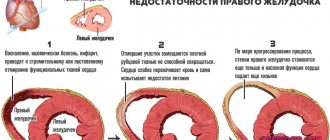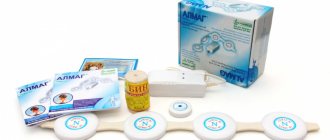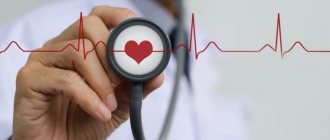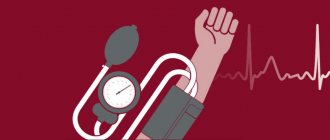A person diagnosed with hypertension should have a lifestyle that differs from the lifestyle of a healthy person, if not radically, then significantly.
Firstly, sufficient space in the daily routine should be given to feasible physical activity (including breathing exercises) and health procedures. Secondly, it is important to regularly relieve emotional stress, that is, to engage in psychological relief.
Lifestyle with hypertension: psychological relief
One of the basic rules of life with hypertension is to protect your psyche from unbearable stress. Psychological relief for hypertensive patients is constantly necessary. Firstly, you need to reduce, as much as possible, the likelihood of conflict situations, both at work and at home. Don’t worry about or without reason, learn to be tolerant of the shortcomings of loved ones and colleagues, and also reduce your emotional response to unusual situations in public transport, on the street, when communicating with neighbors, etc. An instant reaction to a stimulus provokes a surge of adrenaline. As a result, this leads to deterioration in the health of hypertensive patients. However, you can’t push emotions inside either. For this, there are completely “peaceful” ways of detente.
By observing the correct lifestyle for arterial hypertension, you can relieve emotional stress by communicating with pets. Usually they themselves feel that the owner needs help, and readily respond to communication. Take your pet for a walk in the park - pleasure and benefits will be guaranteed. If you have a summer house, then caring for the garden will bring you peace of mind. You can use auto-training in any situation. In order to truly relax, you need to learn how to relieve physical tension. As long as your muscles are tight and tense, relaxation will not work. One by one, mentally giving the command to relax parts of the body, determine where the “clamp” is located. With the power of thought, you can make your body fill with heaviness and warmth, and then imagine its extraordinary lightness. If muscle tension cannot be removed, then you can first try to tighten the tense parts of the body even more, holding the tension for a few seconds, and then relax.
Classical music with a slow tempo is very relaxing for hypertension. You can also choose modern music pieces specially created for relaxation. The main musical background in them is the sounds of nature - the sound of the sea, rain, chirping of birds, etc.
Dancing gives a wonderful release to the body. Smooth movements to music normalize breathing, heart rate, and bring emotional pleasure.
Communication based on interests also distracts from external stimuli. A culinary studio, a sewing or knitting group, a car enthusiasts club - you can choose what you like and devote several hours a week to your hobby.
For older people diagnosed with hypertension, lifestyle should not be reduced to constant rest. Communication with grandchildren brings great pleasure. Not only can they feel younger, but they can also pass on useful experiences. Openness in communication with younger family members and participation in their lives increases trust, and this brings peace of mind and confidence. Explore the world as if you were still 10, 20, 30 years old - interest in new things will not let you get hung up on the disease.
Diet
Paying attention to your health will not only normalize your blood pressure, but also prevent possible complications.
Studies have shown that poor nutrition significantly increases the risk of developing hypertension. First of all, this concerns the abundance of fatty foods. These are some types of meat (pork, lamb), butter and dairy products with a high percentage of fat. This diet is rich in cholesterol, which, when accumulated, forms atherosclerotic plaques on the walls of blood vessels, significantly narrowing the lumen of blood vessels.
In order to cleanse the vascular walls of cholesterol deposits, it is necessary to introduce foods rich in polyunsaturated acids and Omega-3 into the diet. These are sea fish, olive and sunflower oils.
An absolute contraindication for arterial hypertension is increased salt intake. Lingering in the body, it provokes swelling of soft tissues and constriction of blood vessels. This is the main factor in increasing blood pressure. For patients suffering from hypertension, the introduction of smoked meats, canned foods, and salted fish into the diet is highly discouraged.
In order to reduce the negative effects of salt on the body, it is necessary to sufficiently consume foods rich in potassium and magnesium. These are bananas, raisins, tomatoes, seaweed and red peppers.
The diet of a patient suffering from arterial hypertension should not be poor in minerals. This is especially true for vitamin C, which strengthens the vascular wall. Failure to comply with this condition leads to its weakening, followed by a sharp fluctuation in blood pressure numbers. In order for the maximum amount of nutrients to come from food, vegetables and fruits must undergo minimal heat treatment.
One of the most common reasons for the development of hypertension is patient obesity. Therefore, nutrition should be balanced and aimed at regulating body weight. If the patient's body mass index exceeds the normal value, then doctors prescribe a fasting diet.
It implies the following rules:
- reducing the calorie content of foods;
- split meals at least 5 times a day;
- Overeating is strictly prohibited, portions should be small;
- there should be no more than 9 hours between dinner and breakfast.
Many patients, in an effort to lose weight, go on a strict diet and suddenly lose large amounts of body weight. If you have hypertension, such weight loss is strictly contraindicated. The functioning of internal organs is disrupted, which negatively affects the functioning of blood vessels. There is a concept of physiological weight loss. It is 2 - 4 kg per month.
Elevated blood glucose levels can also be a risk factor for the development of arterial hypertension. It is for this reason that patients are contraindicated from consuming large amounts of sweets. In situations where blood glucose approaches the upper limit of normal, the patient is transferred to a special diet that is relevant for diabetes.
As for drinks, if you have hypertension, drinking coffee and energy drinks is not recommended. The caffeine they contain causes vasoconstriction with a subsequent increase in blood pressure. Following a diet in conjunction with following the doctor’s recommendations will help avoid the development of a hypertensive crisis and other serious complications.
Exercise therapy for hypertension
A lifestyle with hypertension must include light to moderate physical activity - it is very good for the heart. They not only relieve muscle tension, but also normalize the emotional background, improve mood, and increase the overall endurance of the body. Physical therapy for hypertension should be carried out under the supervision of a specialist.
At the initial and middle stages of the disease, a general set of preventive measures is usually used:
- morning exercises (can be done at home);
- Physical education classes for hypertension necessarily include therapeutic exercises (exercises while sitting, lying down, standing; with a ball, etc.);
- measured walking;
- walking on uneven terrain (terrenkur);
- training on a simulator;
- therapeutic swimming;
- elements of sports games.
A complex of physical therapy for severe hypertension should be prescribed by a doctor individually. The most commonly used exercises are in a sitting position. If there are no complications, then these exercises can be done at home, remembering that only regular exercise can bring real benefit.
The following describes what exercises to do if you have hypertension to improve your condition.
Lifestyle with high blood pressure
Once a person is diagnosed with hypertension, his lifestyle and diet must change. The patient needs to lead an active lifestyle, eat right, and avoid stressful situations.
The most important rule for high blood pressure is not to be nervous and to be exposed to stressful situations as little as possible. You need to try to avoid conflicts and quarrels, become more tolerant of annoying things, and not worry about trifles. With strong emotional responses, the hormone adrenaline is released into the blood, which provokes an increase in blood pressure.
To reduce tension, you definitely need to unload psychologically. Ideal for this: a favorite activity, a new exciting hobby, communication with loved ones, interesting trips, etc.
What set of physical exercises to do for hypertension (with video)
This set of exercises for hypertension is performed in a sitting position.
1. Sit on the edge of a chair. Place your hands on your hips. Begin to bend your right leg, straightening your left leg at the same time, and then vice versa (without lifting it off the floor!). Try to breathe in and out calmly. Repeat the exercise 5 times.
2. Make a circular motion forward with your right hand and then back. Change your hand and repeat the same exercise again. Repeat this physical exercise for hypertension 5 times.
3. As you inhale, stretch your arms forward and then out to the sides. As you exhale, lower your arms. Repeat the exercise 5 times.
4. As you inhale, place your hands on the seat , and as you exhale, straighten your leg up, while leaning so that your back touches the back of the chair. Repeat the exercise with each leg 5 times in turn.
5. Relax. As you inhale, raise your arms up, then lower them, take them back and lean forward. Exhale without lowering your arms. Repeat the exercise 5 times.
6. To perform this exercise for hypertension, while inhaling, spread your arms to the sides, then use your hands to pull your knee to your chest, while exhaling. Repeat the exercise 5 times.
7. Place your hands on your waist. As you inhale, turn your head and move your right arm to the right and back; as you exhale, return your arm to its original position. Do the same with your left hand. Repeat the exercise 5 times.
8. Stand on your toes. As you inhale, stretch your arms forward, and as you exhale, lower them onto the chair.
Watch the video “Exercises for Hypertension” to better understand how the treatment complex is performed:
Dosed walking for hypertension
Walking is recommended as physical therapy. It allows you to increase the endurance of the body, saturate it with oxygen, strengthen blood vessels and the heart.
Dosed walking for hypertension should be done on level ground and when the temperature outside is comfortable. The first walks should not exceed a distance of 1 km. Gradually, when the body gets used to the loads, the pace and distance are increased. This occurs approximately on the fifth day of the period of regular classes, and sometimes earlier. Then the distance increases to 2 km, and after another 5 days - to 3 km.
In the first days, very slow walking is recommended - if you have hypertension, you need to take no more than 60 steps per minute, then just slow (70 steps per minute), then medium (90 steps per minute) and, finally, fast (120 steps per minute).
At the second stage of hypertension, the pace should not exceed 70 steps per minute.
Breathing while walking should be through the nose. If you want to start breathing through your mouth, reduce the pace. In this case, it is necessary to measure the pulse; as a rule, it will become faster, and this indicates an excessive load on the heart. It is not recommended to fully load the heart; in any case, there should be a small “reserve”.
In addition to regular walking, in sanatoriums, at a certain stage of rehabilitation, walking on uneven terrain (terrenkur) can be prescribed as physical therapy. Usually such routes are marked within the sanatorium. In combination with the previous method - walking on level ground - this type of walking trains the heart well, improves muscle and vascular tone, and improves metabolic processes.
Healthy training is characterized by increased physical activity and is intended for patients with the initial stage of hypertension.
An easy path is limited to a distance of 0.5 km, an average one - 1.5 km, and an extreme one - 3 km. The load may increase depending on the angle of elevation, as well as the pace of walking. The maximum pace is no more than 100 steps per minute. Getting used to the health path is carried out gradually. In this case, every 200 m you need to stop and measure your pulse, note uncharacteristic changes in breathing and heart function. All loads associated with such walking are monitored by a doctor and a specialist in physical therapy.
Physical exercise
Hypertensive patients need exercise. With the help of physical exercise, you can not only stabilize blood pressure, but also improve your overall well-being. Among other things, such loads normalize the activity of the nervous system, eliminating negative emotions. In case of hypertension, the purpose of sports activities is to dilate blood vessels, and this helps to improve blood circulation in muscle tissue and other areas. Such loads strengthen the entire venous and arterial network and normalize the production of cholesterol in the blood.
What sports are suitable:
- swimming;
- cycling;
- walking or jogging;
- water gymnastics;
- some types of dances;
- morning exercises;
- walking up the stairs.
Swimming is the best sport option for people with excess weight or joint pathology. With the help of such loads, the muscles of the upper limbs and back, as well as the area of the hips, knees, and shoulders are perfectly strengthened. During these activities, the entire body is saturated with oxygen.
Hypertensive patients need to ride a bike calmly, on level ground. Such exercises can increase blood circulation and normalize vascular tone, which will certainly have a positive effect on blood pressure.
Walking down the street is beneficial for everyone, without exception. The distance for such walks should be small, especially at the first stage of such training. Later you can increase the number of meters covered, but this must be done gradually. While walking, it is better to control your heart rate. If this indicator increases by more than 20-25 beats in 10 seconds, you need to stop, rest and continue your walk the next day.
Water gymnastics is considered one of the most useful sports, as it can create a special effect from training. During exercise in water, body weight decreases, the efforts of muscle tissue of a statistical nature decrease, which is very relaxing. In addition, with the help of such loads breathing training occurs.
Dancing is suitable for hypertensive patients, but only certain types. Doctors recommend ballroom or oriental dancing, which does not involve sudden movements. The body, with regular exercise, becomes slender, blood supply to all parts of the body improves. Belly dancing also falls into the acceptable category, since during its performance the abdominal muscles are strengthened.
Exercising in the morning and walking up the stairs for a short period of time helps as much as other sports. Some people don't have enough time to go to gyms or swimming pools. At home, you can also organize such activities, which will significantly improve the well-being of hypertensive patients.
Physical activity for hypertension: exercise in the gym
Physical activity for hypertension can include exercise in the gym - such workouts provide good help in strengthening the heart and blood vessels. The body becomes more resilient, the cardiovascular system gets used to certain loads.
Exercising in the gym with hypertension is contraindicated for the following concomitant diseases:
- moderate to severe heart failure;
- thrombophlebitis;
- tachycardia;
- exacerbation of angina pectoris;
- acute infectious diseases.
The load on the heart should be the same as when walking - no more than 80%. It is necessary to take 10-minute breaks during the lesson to measure the pulse: it should be below 30% of the maximum norm for the patient’s age.
You need to start and finish exercises on the simulator slowly, noticeably relaxing towards the end. It is recommended to exercise on the simulator no more than 30 minutes a day, 3-5 times a week. If you plan to conduct training at home, then you need to establish constant contact with your doctor so that he can monitor your condition. It is advisable to record heart rate and blood pressure readings during training on the simulator in a diary.
Organization of the daily routine
The correct daily routine is very important for a person suffering from arterial hypertension, especially if the patient is already advanced in age. There are certain rules that help you plan your day on your own.
- You need to get up in the morning and go to bed in the evening at the same time. If a person always gets up early, at about 7 am, then he should go to bed no later than 10 pm.
- Before going to bed, you should not watch action-packed films or TV programs that will cause excitement and worry.
- Walking outside before bed will improve well-being and restore the emotional state of the patient.
- In the morning you need to do gymnastics, this will increase blood circulation and metabolism. Sudden movements and bends should not be made.
- Meals should be taken in small portions, 4-5 times a day.
- All household chores should only bring benefits; excessive stress, prolonged stay in an inclined position when the head is down, can provoke an increase in blood pressure.
- All water procedures should be carried out at the optimal water temperature, which is 37-38 degrees. Better take a shower.
Loneliness has a negative impact on the condition of hypertensive patients. Communication gives people positive emotions, so you need to spend some time talking with loved ones, family, friends and neighbors. Doctors have proven that joy and satisfaction with your own life normalize blood pressure, so you should strive to receive only good sensations and emotions.
A person who has arterial hypertension needs special living conditions. By creating a favorable atmosphere for themselves and following all the rules described by the doctor, people help their body cope with the disease.
Therapeutic massage for hypertension and contraindications
Massage for hypertension is most useful at the initial stage of the disease, when it serves as a way to relax. It can also be used for non-progressive hypertension, when a person undergoes regular treatment and prevention.
The most problematic areas for blood circulation in hypertension are the collar area, as well as the scalp and frontal part of the head. Massage for arterial hypertension in these particular areas can bring tangible relief, reducing tension and establishing normal blood circulation. Massage movements should be soft, smooth, with a certain rhythm and in no case intense. On the head, the occipital protuberances and the area between the eyebrows are first massaged. You should spend no more than 15 minutes a day on massage. The course should be carried out for 20-25 days.
Body massage - the chest and upper back area - should be carried out using soft and light strokes in a certain rhythm. During a therapeutic massage for hypertension, you can use relaxing oils.
General contraindications for massage:
- hypertensive crisis and 3-4 days after it;
- severe stage of hypertension;
- diseases (including chronic ones) in the acute stage;
- inflammatory processes of any localization;
- increased bleeding, capillary fragility;
- internal bleeding or tendency to it;
- blood diseases;
- skin diseases and damage to the skin;
- fungal diseases;
- phlebeurysm;
- thrombophlebitis;
- impaired patency of peripheral arteries;
- cerebral circulation disorders (including against the background of atherosclerosis);
- aneurysms of blood vessels;
- inflammation of the lymph nodes and lymphatic vessels;
- enlarged lymph nodes (including painless ones);
- severe physical and nervous fatigue;
- benign and malignant tumors;
- severe mental illness;
- strong pain;
- dysfunction of the kidneys, liver, cardiovascular system.
special instructions
It is worth noting that the disease does not occur immediately, but creeps up unnoticed. It all starts with a headache, black spots before the eyes and dizziness. You should never take medications for high blood pressure without a doctor's prescription. What suits one person will not necessarily suit another. Uncontrolled use of medications can lead to deterioration of health. Hypertension can be treated with medications and lifestyle changes.
Psychological rest
One of the main reasons why the heart beats faster is stress, so hypertensive patients need to learn not to get nervous over trifles. After a hard day or a conflict situation, you need to try to relieve stress. Drawing, knitting, modeling, reading a book or listening to calm, relaxing music are suitable for this. A light cervical massage is also perfect. However, intense rubbing can only harm the blood vessels. Acupressure or underwater massage is also suitable.
Sleep plays an important role in establishing psychological balance. Hypertensive patients should sleep at least 8 hours so that the body has time to fully recover after a hard day. Lack of sleep threatens exhaustion of the nervous system, and as a result, increased blood pressure and headaches. Rest is useful for this disease, but you should not go to bed during the day - the body loses its rhythm and does not have time to properly rest in a short period of time.
Nutrition for hypertension
Those suffering from arterial hypertension face food restrictions; fried and salty foods should be excluded from the diet. Sodium in salt provokes water retention in the body, and excess fluid causes increased blood pressure. A large amount of fatty and fried foods consumed can lead to the formation of plaques in the vessels, further narrowing the already narrow vessels of hypertensive patients.
Acupressure for hypertension (with video)
A type of massage is acupressure. The good thing about it is that you can influence the active points to reduce pressure at home. But before that you need to consult your doctor.
Contraindications for acupressure for hypertension are:
- coronary insufficiency, which is accompanied by frequent attacks of angina and cardiac asthma;
- aortic aneurysm;
- atrial fibrillation, arrhythmia, paroxysmal tachycardia;
- acute inflammatory diseases of the myocardium and membranes of the heart;
- circulatory failure of the 2nd and 3rd degree;
- hypertension of the 3rd degree;
- late stages of cerebral atherosclerosis;
- active phase of rheumatism;
- thrombosis;
- significant varicose veins with trophic disorders;
- enlarged, painful lymph nodes;
- acute cardiovascular failure.
If you are doing acupressure, then to do this you need to sit down, relax, and establish an even rhythm of breathing. Massage can be performed with the pads of only three fingers - thumb, index or middle. If an asymmetrical massage is performed, it is performed with the index finger of the left hand.
The treated area is first kneaded, then circular vibrating pressure is applied. The points are massaged with small circular movements in a clockwise direction; the degree of pressure should be gradually increased, and by the end of the procedure, loosened. You need to do approximately 35-40 massage movements.
Reflex points for the treatment of hypertension are located in the neck, parotid area, in the area of the forearms and feet.
The main options for acupressure are as follows.
1. With the thumb of your right hand, feel the place in the lower jaw on the right where the carotid artery pulsates , and with your index finger on the left, press lightly, count to 10, release, inhale and press again. You should feel the pulsation of the treated area all this time. After performing the massage three times, apply light pressure movements to the points on the front and side of the neck.
2. Using your middle fingers, press the points at the back at the base of the skull 3 times , moving towards the occipital protuberance. Count to 10 with each approach, gradually increasing the pressure.
3. Simultaneously press with three fingers of both hands on the pits to the right and left of the spine on the back of the neck in a downward direction. Count to 10 with each approach, gradually increasing the pressure. Repeat 3 times.
4. Massage those points that are 4 fingers below the kneecap (both on the left and right leg) at the same time. The procedure time is 5 minutes.
5. Massage the reflex points for 5 minutes , which are located 4 fingers above the edge of the inner side of the ankle.
A properly performed massage will cause a feeling of warmth in the massaged areas and a slight tingling sensation.
There are other ways to help reduce blood pressure.
The first method: feel the depression behind the earlobe and, pressing lightly, draw a straight line to the collarbone. Repeat the exercise 10 times, on both the left and right sides of the neck.
Second method: massage the point between the eyebrows for a minute.
The video “Acupressure for hypertension” shows how basic techniques are performed:
Treatment of hypertension with breathing: therapeutic breathing exercises
Breathing exercises for hypertension are a relatively new type of disease prevention. The main emphasis is not on the exercises themselves, but on breathing techniques. The main thing is to gradually develop a breathing rhythm.
Breathing exercises for hypertension using the method of A. N. Strelnikova, which is adopted by specialists, are especially effective, adapting it to each patient individually.
The principle of this type of gymnastics is as follows: starting with a short, noisy inhalation through the nose, you need to exhale freely without focusing on it. This technique is repeated 4 times, after some time the number of inhalations and exhalations doubles, ultimately reaching 32 breaths.
In addition to breathing exercises, short breathing relaxation is also recommended for treating hypertension at home - it helps reduce blood pressure caused by heavy mental or emotional stress. You need to lie down, relax as much as possible, and not think about your experiences.
Inhale arbitrarily and hold the exhalation for about 8 seconds. You need to perform breathing exercises for 3-4 minutes.
The method of diaphragmatic breathing, used in physical therapy, is also recommended as therapeutic breathing for hypertension. It is based on helping hypertensive patients control their respiratory rhythm. This method allows you to saturate the body with oxygen, strengthen blood vessels in the diaphragmatic area, improve blood supply to the heart, and regulate blood flow.
To treat hypertension with breathing, lie on your back, bend your knees, relax your abdominal muscles. Place your hands on your stomach to feel the air movement. Inhale through your nose and “inflate” your stomach. When exhaling through your mouth, release the air slowly (in small portions), while simultaneously “blowing out” your stomach.
Baths and wraps for hypertension
For hypertension, special baths are useful. They can be general (when the whole body is immersed in water) and local (when arms or legs are immersed in water).
General baths are divided into those that can only be taken in medical institutions, and those that can be taken at home. Baths in a clinic (sanatorium, dispensary) are taken under the supervision of a specialist. There are several types of baths that are intended for the prevention of hypertension at different stages: mineral (chloride, sodium, magnesium, calcium, bicarbonate, sulfate and their mixed types, carbon dioxide, hydrogen sulfide), nitrogen, salt (including radon), mud. The listed types of baths may not be suitable for all patients due to individual intolerance and unidentified body disorders. This may not appear immediately, so if you feel worse while taking a bath or immediately after it, you should inform your doctor.
At home, baths for hypertension with the addition of pine extract are recommended, which give a calming effect. Baths with the addition of essential oils of pine, fir, cedar, lavender, citrus fruits, and roses have a good effect on the nervous system. The water in the bath should not exceed 37 °C, since too hot water will have the opposite effect - extra stress on the blood vessels. Before adding essential oil (20 drops) to water, you need to dissolve it in 1 tablespoon of milk so that it does not irritate the skin. The bath should take no more than 10-15 minutes.
For baths, you can also use sea salt with pine needle extract.
Of the local baths, mustard is most often used - for the feet. The water temperature should not exceed 40 °C. Baths with mustard are good for reducing blood pressure. They can be used as first aid for hypertensive crisis. The duration of the bath is no more than 20 minutes.
In a hospital setting, in the initial or middle stages of hypertension, local Gauff baths can be used to improve blood circulation in the heart - for the arms and legs at the same time. It can be difficult to use them at home. Hands and feet are immersed in water heated to 37 °C and the temperature is raised to 42 °C for 15 minutes, after which the water temperature is maintained at this level for about another 15 minutes. The course of treatment with Gauffe baths is 10-15 procedures.
Baths for hands and feet differ from general baths in that they are hot, i.e. their temperature is higher. This is done so that the source of activation of blood circulation is further from the heart, while there is no excessive expansion of the cardiac arteries and no load on the heart itself. Due to peripheral vasodilation, the heart rate slows down and blood pressure decreases.
Varicose veins are a contraindication for local baths.
Another useful water treatment is using a wet wrap. A wet, wrung-out sheet is laid out on top of a flannelette or woolen blanket, the patient is placed on it and asked to stretch out his arms. Then they wrap one end of the sheet around the patient, lower their arms and cover them with the other end of the sheet. They wrap him in a sheet almost up to his shoulders and wrap him in a blanket. In this case, the temperature of the water for soaking the sheet should be about 30 ° C, and the wrapping should occur quickly so that the person does not have time to freeze and does not experience vasospasm. The procedure lasts approximately 55 minutes. For hypertensive patients with normal weight, 45 minutes is enough. Wet wrap has a great effect on the central nervous system, improves blood circulation, strengthens the heart, and normalizes metabolism.
General recommendations for hypertensive patients
It is important to learn about the existing features of hypertension at the first signs of the disease. Self-treatment and attempts to reduce blood pressure using unconventional methods can be more than dangerous. The attending physician will tell you what contraindications there are for hypertension, because only he will be able to assess the patient’s condition. You should pay attention to the main aspects and be prepared for major changes.
Lifestyle
In addition to adequate therapy, it is important for a person suffering from high blood pressure to pay attention to their lifestyle, review their diet and eliminate factors that increase the risk of increased blood pressure.
To prevent the development of arterial hypertension, it is important to resort to preventive measures from a young age. A healthy lifestyle and overcoming bad habits are the key to good health.
To keep the body in shape, it is simply necessary to exclude predisposing factors, learn about a possible predisposition to hypertension, and also do not forget about contraindications.
Experts always advise adhering to the basic rules and eliminating factors that provoke increased blood pressure:
- consumption of alcoholic beverages;
- smoking;
- stressful situations;
- neglect of rest and proper sleep;
- products harmful to the body;
- great physical and psychological stress.
It is important to remember that surges in blood pressure are the first step to coronary heart disease.
Leisure
Sleep and wakefulness, namely correct ones, are necessary for a patient with a similar pathology.
The changes that occur with hypertension depend on the person's activity. To avoid complications and for the normal functioning of all body systems, it is important to get enough rest, but also not to forget about small and necessary loads. Activity for hypertension must be balanced and dosed. There are several exercises that are essential for hypertensive patients. To keep blood pressure at a normal level, patients are recommended to jog and race walk, but strength training should be excluded. Excessive fatigue and pain when performing them may be indications for stopping certain exercises.
It is also important to find time for rest, but you cannot get carried away with it. A sedentary lifestyle can lead to the development of not only persistent hypertension, but also cause disturbances in other body systems.
Constant monitoring of blood pressure will prevent sudden jumps. By keeping a special diary, a hypertensive patient will be able to determine for himself what intensity of exercise is allowed, and when to give the body a rest.
Treatment of hypertension with essential oils: hypertonic compresses
Compresses with mustard are most often used for hypertension. To do this, dilute mustard in warm water, moisten a bandage or towel with the solution and apply it to the calf muscles.
Hypertonic compresses with sea salt help reduce blood pressure and improve blood circulation. The base is prepared in the same way as in the previous case. Compresses are placed on the forehead, closer to the area between the eyebrows. You need to keep the compress for 15-20 minutes. To obtain a noticeable effect, you need to do this procedure for at least a week.
Essential oils can be used for compresses, but they must first be diluted with milk or water (1 tablespoon) to avoid skin irritation. Place the compress on the forehead close to the area between the eyebrows and keep it there for no more than 20 minutes. For aromatic compresses when treating hypertension with oils, the following combinations can be used.
1. Tangerine oil (3 drops) + lemon or lime oil (2 drops) + fir oil (1 drop).
2. Geranium oil (2 drops) + lavender oil (1 drop) + cypress oil (1 drop) + lime oil (1 drop).
3. Tangerine oil (3 drops) + ylang-ylang oil (1 drop) + marjoram oil (2 drops).
For hypertension, essential oils can be combined with salt compresses.
In warm water (about 200 ml) you need to dissolve sea salt, add 2 drops each of marjoram, lavender, ylang-ylang, mandarin and geranium oils. Soak a towel or a bandage folded several times in this mixture and apply to the calves or the lower part of the back of the head.
Reflexology for hypertension: acupuncture treatment
Acupuncture (acupuncture) is widespread in Eastern medicine. This method of therapy has found its application in the prevention of various diseases around the world. Treatment of hypertension with acupuncture involves influencing active points of the body.
Acupuncture has a positive effect both on the functioning of organs and systems of the body, and on the entire body as a whole, depending on the selected method for treating a specific disease. Acupuncture is most effective in the early and middle stages of hypertension.
Reflexology for hypertension using acupuncture has the following contraindications:
- pregnancy;
- heat;
- acute febrile conditions;
- acute inflammatory processes of any localization;
- skin damage in the treated area;
- acute hypotensive and hypertensive crises;
- severe diseases of the cardiovascular system (ischemia, post-infarction and post-stroke condition, grade 3 hypertension);
- active form of tuberculosis;
- syphilis;
- benign and malignant neoplasms;
- pain of unknown nature on palpation of the abdomen;
- nausea, vomiting;
- the period of preparation for surgery and after it;
- severe mental illness;
- individual intolerance to metals contained in the needle.
In a clinical setting, to treat hypertension with acupuncture, you need to contact a good reflexologist who can choose the right complex just for you.


